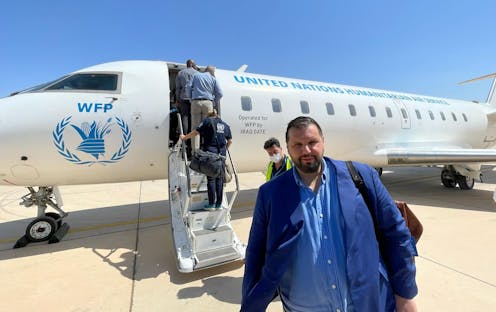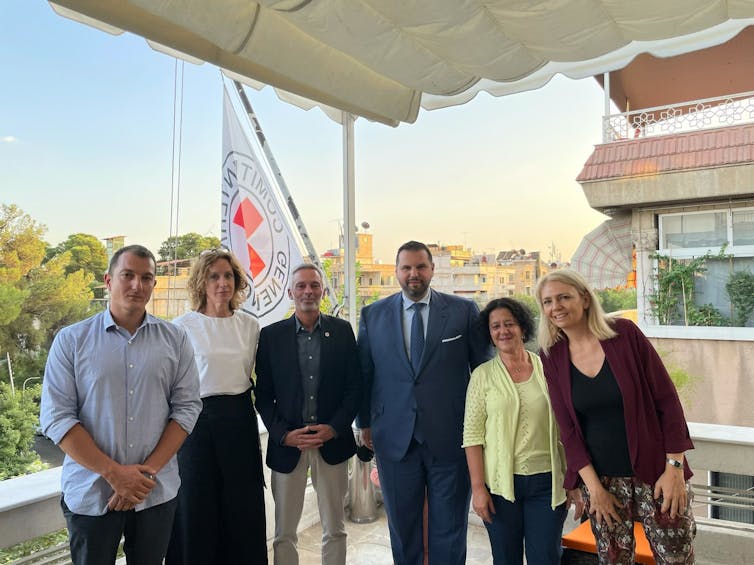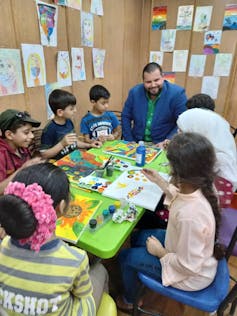
Since 2011, Bashar Al-Assad has waged a brutal war that has taken the lives of hundreds of thousands of Syrians – estimates range between 306,000 and 610,000 victims. Overwhelming evidence ties Al-Assad to a range of war crimes and genocidal practices, and the European Union has long advocated a firm stance against his regime.
The EU Delegation for Syria, which moved to Beirut in 2012, is designed to promote European values and supervise EU external relations and aid policy. In the name of pragmatism, it has recently tended to change its tone toward the Syrian government in place. What are the consequences?
A firmness that only lasted so long
Six months after the start of the Syrian revolution, Catherine Ashton, then EU High Representative for Foreign Affairs and Security Policy, demanded the departure of Bashar Al-Assad. This was in line with the strategy adopted within the UN Security Council by the United States and a majority of European countries, including France and the United Kingdom.
In an August 2012 speech, US president Barack Obama defined a “red line” that, if crossed, would lead to devastating consequences for the Damascus regime: the use of chemical weapons. Just a year later, Al-Assad did just that in Eastern Ghouta, yet the attack remained without consequences. Washington’s reversal heralded the EU’s gradual shift.
Indeed, from 2015 onwards, the fear of a “refugee crisis”, coupled with the initial successes of Russian intervention and the establishment of “de-escalation zones” in Syria, led the EU to focus on economic sanctions and humanitarian aid. It thus ruled out the possibility of trying to exert political influence to facilitate a resolution of the conflict.
At the time, researcher Dimitris Bouris and Anis Nacrour, former head of the EU delegation to Syria, asserted that EU was “reducing its room for manoeuvre to the role of financial partner and provider of technical assistance to UN mediation initiatives.” With the West no longer calling for Al-Assad’s departure with the same vigour, Damascus’s allies began to assert that he had won the war – and this, despite the persistence of systematic even genocidal violence.
The EU has gradually adopted the idea of an [“early rehabilitation plan”]plan (https://www.eeas.europa.eu/eeas/opportunities-strengthening-resilience-and-advancing-early-recovery-syria_en), is heavily involved in Syria alongside the UN, which has continued to call for a ceasefire combined with a Syrian-initiated political solution since the Security Council’s unanimous adoption of resolution 2254 in December 2015).
This cooperation is manifested in the annual conference on aid for the future of Syria and the countries of the region. In May 2022, 6.4 billion euros were mobilised.
Recent EU diplomatic movements
Until 2021, the EU delegation to Syria remained discreet about the composition of its team, its activities and its movements in Damascus.
That changed with the September 2021 appointment of Romanian diplomat Dan Stoenescu to head the delegation. In his first official trip to Damascus, he met with Imran Raza, UN resident coordinator, as well as representatives of humanitarian aid agencies, including the Red Cross, UNDP, WHO and the World Food Programme, as well as numerous diplomats.

With this first visit to the regime-controlled area, Stoenescu broke the European promise not to favour Al-Assad’s quest for legitimacy. The presence of European diplomats whose Syrian embassies had closed since 2012 (only the Czech Republic’s embassy remained open; currently, seven European embassies are open) also breaks the taboo of resuming a form of exchange.
The visits are described in full transparency on the delegation’s and Stoenescu’s Facebook pages. On 8 August 2022, Stoenescu goes on a “four-day humanitarian mission” together with Imran Raza. Three cities under the control of the regime are visited for the first time: Homs, Hama and the martyred city of Aleppo.
Archetypes of humanitarian and reconstruction discourse
The delegation’s communication is that of a diplomatic service addressing a European audience that used to observing “suffering at a distance”, to use Hannah Arendt’s phrase. Through its role as mediator, it must inform the citizens of the member countries but also of the whole world and convey its conception of a form of social responsibility. No culprit is named: the delegation does not opt for what the sociologist Luc Bolstanski defines as the “topic of denunciation”, which “turns away from the depressing consideration of the unfortunate and his suffering to look for a persecutor”, only the “topic of feeling”, which directs attention toward a benefactor and the good actions he or she accomplishes.
The responsibility here is humanitarian: it mobilises the “iconography of help”. Any case of suffering requires a good action, “regardless of what brought the suffering on or what the consequences of assisting might be”.
The European action is divided into two parts: early reconstruction in the territories under the control of the regime, and humanitarian aid for refugees and displaced persons. The political scope of this strategy is relegated to the background. Stoenescu’s reaction to the Security Council’s adoption of resolution 2642, which limits cross-border aid operations in northwestern Syria to six months so as to prevent Russia from using its veto power, is an example:
“The humanitarian needs of Syrians, the majority of whom are women and children, should not be politicised! […] Cross-border operations must be depoliticised and must increase.”
Through passive forms focusing on the plight of the victims, the names of those responsible for the abuses are carefully avoided, leading to a disempowering effect:
“I am outraged by the recent attacks in northern Syria that are said to have killed more than 17 people […] Innocent people continue to be victims of this conflict!”
Syrians, on the other hand, are described here as a homogeneous group, thus erasing the existence of oppressors and oppressed. To quote the delegation’s official website : “The EU and the Syrians have a common goal: a stable and peaceful Syria”; “our interest, as Europeans, is the same as what the Syrians want”.
To support its discourse, the delegation uses photographs to create the picture of a people “rebuilding” themselves through the reconstruction of schools, medical facilities, an infrastructure.

These emotionally powerful situations captivate the imagination of an often uninformed public, organise its “cultural knowledge” of the region, and consolidate an idealised conception of the political situation in Syria. Thus, European readers discover “resilient” children colouring and singing together in a youth centre in Aleppo, or playing music in al-Qusayr.
Images from the Directorate General for Civil Protection and European Humanitarian Aid Operations or the UN High Commissioner for Refugees sometimes counterbalance these idealised images. Refugee children, this time destitute, sitting on crates stamped “UNICEF”, as well as mothers and infants suffering from the cold of the camps in northeast Syria. These images appeal to Western preconceptions and emphasise the need to maintain international humanitarian assistance as it is.
Early rehabilitation policy: what are the risks?
The vision of the conflict conveyed by the EU and the UN has been denounced by politicians, activists, researchers and Syrian civil society organisations, who warn that this policy must not be transformed into a political and financial support to Bashar Al-Assad.
At stake are the misappropriations of funds organised by the Syrian regime, which have generated headlines and reports alike. The Syria Trust, founded by Bashar Al-Assad’s wife, is an example of how international aid can enrich the president’s inner circle. The scandal affecting UN agencies present in 2018 in Aleppo illustrates the risks of co-optation. The regime systematically bombed of the eastern part of the city, destroying schools, hospitals, homes, and infrastructure. Yet UN experts were forced by the regime to work only in the neighbourhoods of western Aleppo.
In such a context, Stoenescu’s recent trip to al-Qusayr – a city that was violently recaptured by Hezbollah and Shiite militias in 2013 – raises questions. While described as apolitical and humanitarian, this official visit can’t help but endorse the regime’s strategy. In al-Qusayr, the 2019 return of refugees escorted by Hezbollah supported the regime’s official discourse that the country was now stabilised and safe.
Finally, the plan implemented by international agencies is not without dramatic consequences for Syrians seeking justice and accountability: reconstruction can lead to the erasure of war crimes, for example in the case of schools bombed by the regime.
Consequently, the current UN and EU strategy needs to be challenged so that in the future it makes trusted local intermediaries a central part of conflict resolution. Such action will limit the leakage of European funds, corruption and co-option of humanitarian aid, and the process of normalisation of relations with the regime.
Élise Daniaud received a PhD contract from the LUISS Guido Carli University.
Yahia Hakoum received a research grant.
This article was originally published on The Conversation. Read the original article.







